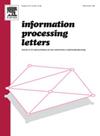不同私人设施位置的改进下限
IF 0.6
4区 计算机科学
Q4 COMPUTER SCIENCE, INFORMATION SYSTEMS
引用次数: 0
摘要
我们考虑的是古普塔等人[13]提出的所谓超集输出环境下的差异化私有(DP)设施定位问题。Cohen-Addad 等人[3]提出的ϵ-DP 算法目前已知的最佳预期近似率是 O(lognϵ),其中 n 表示度量空间的大小,而已知的最佳下限是 Ω(1/ϵ) [8]。在这篇短文中,我们给出了任何ϵ-DP 算法的预期逼近率下限 Ω˜(min{logn,lognϵ}),这是逼近率必须随度量空间大小增长的第一个证据。本文章由计算机程序翻译,如有差异,请以英文原文为准。
Improved lower bound for differentially private facility location
We consider the differentially private (DP) facility location problem in the so called super-set output setting proposed by Gupta et al. [13]. The current best known expected approximation ratio for an ϵ-DP algorithm is due to Cohen-Addad et al. [3] where n denote the size of the metric space, meanwhile the best known lower bound is [8].
In this short note, we give a lower bound of on the expected approximation ratio of any ϵ-DP algorithm, which is the first evidence that the approximation ratio has to grow with the size of the metric space.
求助全文
通过发布文献求助,成功后即可免费获取论文全文。
去求助
来源期刊

Information Processing Letters
工程技术-计算机:信息系统
CiteScore
1.80
自引率
0.00%
发文量
70
审稿时长
7.3 months
期刊介绍:
Information Processing Letters invites submission of original research articles that focus on fundamental aspects of information processing and computing. This naturally includes work in the broadly understood field of theoretical computer science; although papers in all areas of scientific inquiry will be given consideration, provided that they describe research contributions credibly motivated by applications to computing and involve rigorous methodology. High quality experimental papers that address topics of sufficiently broad interest may also be considered.
Since its inception in 1971, Information Processing Letters has served as a forum for timely dissemination of short, concise and focused research contributions. Continuing with this tradition, and to expedite the reviewing process, manuscripts are generally limited in length to nine pages when they appear in print.
 求助内容:
求助内容: 应助结果提醒方式:
应助结果提醒方式:


